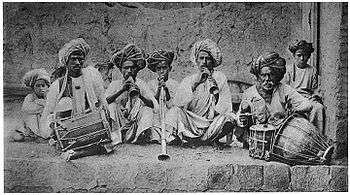Mang (caste)

Māng musicians with drums, Solapur (Russell, 1916)
.jpg)
Mangs in Shrigonda (c. 1855-1862).
The Mang or Matang (Minimadig in Gujarat and Rajasthan) community is an Indian caste, historically associated with low-status or ritually impure professions such as village musicians, cattle castraters, leather curers, midwives, hangmen, undertakers.[1]In the modern day they are listed as a Scheduled Caste, a designation which has replaced the former term Untouchable.Their origins lie in the Narmada Valley of India.
Distribution
Per the 1981 census, the majority of Mang lived in Maharashtra (1,211,335), with much smaller amounts in Gujarat (2,765); Goa, Daman, and Diu (702) and Rajasthan (241).
Social status
In the early 20th century, the Mang began to form caste associations to advocate their cause, such as the Matang Samaj (1932) and Matang Society (1923).[2][3]
Notables
- Annabhau Sathe, Maharashtra social reformer,Poet,writer
- Lahuji Raghoji Salve, Maharashtra social reformer
References
- ↑ Robert Vane Russell (1916). pt. II. Descriptive articles on the principal castes and tribes of the Central Provinces. Macmillan and Co., limited. pp. 188–. Retrieved 14 August 2012.
- ↑ Surajit Sinha (1 January 1993). Anthropology of Weaker Sections. Concept Publishing Company. pp. 330–. ISBN 978-81-7022-491-4. Retrieved 24 August 2013.
- ↑ Prahlad Gangaram Jogdand (1991). Dalit movement in Maharashtra. Kanak Publications. Retrieved 24 August 2013.
Further reading
- Constable, Philip (May 2001). "The Marginalization of a Dalit Martial Race in Late Nineteenth- and Early Twentieth-Century Western India". The Journal of Asian Studies. 60 (2): 439–478. doi:10.2307/2659700. JSTOR 2659700. (subscription required (help)).
| Wikimedia Commons has media related to Matang (caste). |
This article is issued from Wikipedia - version of the 11/20/2016. The text is available under the Creative Commons Attribution/Share Alike but additional terms may apply for the media files.